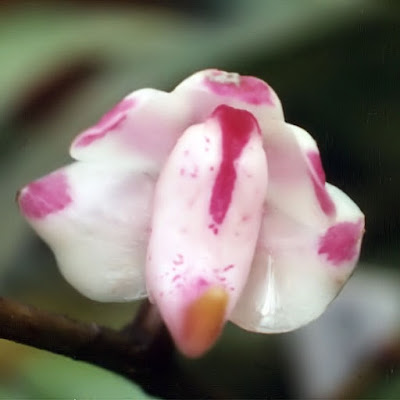Aerides odorata orchid is native to China (Yunnan, Guangdong), Himalayas, Bhutan, Assam, Bangladesh, India, Nepal, Andaman and Nicobar Islands, Myanmar, Thailand, Laos, Cambodia, Vietnam, Peninsular Malaysia, Borneo, Sumatra, Java, Sulawesi, the Lesser Sunda Islands, and the Philippines in broadleaf, evergreen, lowland forests at elevations of 200 to 2000 meters high up in trees in bright sun.
Aerides odorata orchid, also called as The Fragrant Aerides, Aerides odoratum, is a species in the genus Aerides. Several synonyms are know for this species such as: "Aeeridium odorum Salis. 1812"; "Aerides ballantiniana Rchb.f. 1885"; "Aerides cornuta Roxb. 1832"; "Aerides dayana hort. 1933"; "Aerides jucunda Rchb.f. 1860"; "Aerides latifolia (Thunb. ex Sw.) Sw. 1806"; "Aerides micholitzii Rolfe 1904"; "Aerides nobilis Warn. 1862"; "Aerides odorata f. immaculata (Guillaumin) M.Wolff & O.Gruss 2007"; "Aerides odorata subvar. immaculata Guillaumin 1934"; "Aerides odorata Lour. var alba"; "Aerides odorata var. annamensis Costantin 1917"; "Aerides odorata var. ballantiniana (Rchb.f.) A.H.Kent 1891"; "Aerides odorata var. birmanica Rchb.f. 1887"; "Aerides odorata var. demidovii Linden 1885"; "Aerides odorata var. eburnea Cogn. 1904"; "Aerides odorata subvar. immaculata Guillaumin 1934"; "Aerides odorata var. major Ortgies 1859"; "Aerides odorata var. micholitzii (Rolfe) Guillaumin 1963"; "Aerides odorata var. pallida Guillaumin 1962"; "Aerides reichenbachii Linden 1858"; "Aerides reichenbachii var. cochinchinensis Rchb.f. 1880"; "Aerides rohaniana Rchb. f. 1884"; "Aerides suaveolens Blume 1849"; "Aerides suaveolens var. virens (Lindl.) Blume 1849"; "Aerides suavissima Lindley 1849"; "Aerides virens Lindley 1843"; "Aerides wilsoniana R.H. Torr. 1885"; "Epidendrum aerides Rausch 1797"; "Epidendrum odoratum 1810"; "Limodorum latifolium Thunb. ex Sw. 1799"; "Orxera cornuta Raf. 1836"; "Polytoma odorifera Lour. ex B.A.Gomes 1872".
IDENTIFY AERIDES ODORATA ORCHID
Aerides odorata orchid is native to China (Yunnan, Guangdong), Himalayas, Bhutan, Assam, Bangladesh, India, Nepal, Andaman and Nicobar Islands, Myanmar, Thailand, Laos, Cambodia, Vietnam, Peninsular Malaysia, Borneo, Sumatra, Java, Sulawesi, the Lesser Sunda Islands, and the Philippines in broadleaf, evergreen, lowland forests at elevations of 200 to 2000 meters high up in trees in bright sun.
This species is a large to giant sized, highly variable, hot to cool growing epiphyte with very stout, drooping, branching stems carrying fleshy, incurved, oblong-ligulate, round lobed at the apex, broad, pale green leaves. Leaf blade broadly lorate, 15-20 × 2.5-4.6 cm, thickly leathery, obtuse and unequally bilobed. Inflorescence numerous, nodding, racemose, 15-30 cm, densely 20-30-flowered; floral bracts broadly ovate, 5-9 mm, obtuse.
Aerides odorata orchid blooming in June or July, and remaining two or three weeks in good condition. The blossoms are white, shaded with pink, and have a delightful perfume. Flowers fragrant, opening widely, 1.5-3 cm in diam., purple to almost white, often tipped and spotted purple, spur apex greenish yellow; pedicel and ovary 1-2.5 cm, slender. Dorsal sepal elliptic, ca. 10 × 8 mm, obtuse-rounded; lateral sepals broadly ovate, ca. 12 × 9 mm, adnate at base to column foot, apex obtuse. Petals subelliptic, 11-12 × 5-7 mm, base contracted, apex obtuse; lip immovable, spurred, 3-lobed, almost enclosing column; lateral lobes erect, obovate-cuneate, ca. 15 × 10 mm, distal margin irregularly toothed, apex obtuse-rounded; mid-lobe linear, ca. 12 × 3 mm, bilobed; spur bent forward, narrowly horn-shaped, ca. 1 cm.
There are also solid pink varieties of this species, alba forms and unusual greenish-yellow variety with purple tips of sepals and petals: Aerides odorata cornutum (from India, distinct in growth from the former; spikes about twelve inches long, furnished with pink and white-coloured flowers, which are produced in May, June, and July, and continue upwards of three weeks in bloom), Aerides odorata (like Aerides odoratum in growth, and differing only in the larger and longer spikes of flowers), Aerides odorata purpurascens (with broad dark green leaves, free bloomer, producing a long massive spike of large flowers, which are white tipped with bright pink), Aerides odorata rubrum (with dark green foliage, Saccolabium ampullaceum would like this, the colour being similar and the spikes longer), Aerides odorata suavissimum (light green foliage ten inches long, spotted with brown. The sepals and petals are white, and the lip has a blotch of yellow in the centre edged with white, blooms in July, August, and September, and lasts in good condition three weeks).
GROW AND CARE AERIDES ODORATA ORCHID
The Aerides odoratum is the most easy to grow so they are could be recommended for beginners.
Light, humidity and temperature:
They require bright filtered light with some direct sunlight in the morning, semi-shade area placement is perfect. The temperatures should be intermediate to warm and hot. 70% or higher relative humidity is beneficial although the plants can be grown lower.
Watering:
Watering should be regular, allow the roots to dry between watering. It is best to use rainwater, distilled or reverse osmosis water. Municipal water with a pH of 7.5 or lower can also be used. In hot or dry climate, we should put a bowl of water under the plant to increase the moisture of the atmosphere around the plant.
Potting:
Plants are best grown hung in baskets or mounted. Plants should be grown in media that is well drained such as tree fern fibers (for small plants), several pieces of coarse fir bark, or sphagnum moss or with no media at all.
Fertilizer:
Aerides odorata orchid is a species of orchid with strong vitality, self-nutrients from the air so not need to fertilize much, use fertilizer 20-20-20. Dissolve ½ teaspoon of fertilizer in 4 liters of water, spray drenched leaves, roots every 15 days in the morning.















COMMENTS